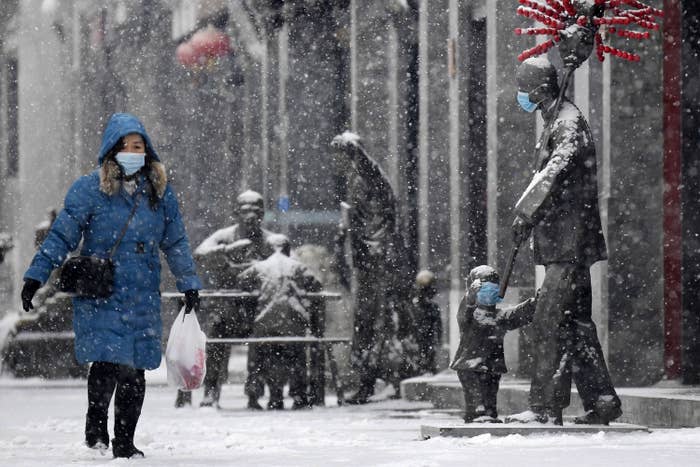
A cruise ship filled with ever more sick passengers. A second death outside China. An overnight jump of over 15,000 additional people diagnosed with a new, dangerous, coronavirus.
It’s all bad news, and a tragedy for the 1,370 people who have died in the outbreak, still just over a month old. But the skyrocketing case count, driven primarily by last night’s jump, doesn’t point to a worldwide explosion of the disease now called COVID-19, public health experts say. Instead, it's due to a change in how the case numbers are being counted.
“We’re not dealing with a spike of 14,000 cases in one day,” said the World Health Organization’s Mike Ryan, executive director of the Health Emergencies Programme, speaking at a Thursday news conference. WHO officials had warned the jump was coming for the last few days, anticipating a change in diagnosis criteria.
Until now, cases had only been confirmed by lab tests finding the virus in swab samples from patients. But in Hubei province, patients with lung scans showing the signature pneumonia seen in COVID-19 cases over the last several weeks were just added to the case totals, causing the overnight jump. (Everywhere else in the world, confirmation still requires a lab test result.)
That caused a 34% overnight jump in the most recent case counts. A total of 60,360 people were diagnosed with COVID-19 as of Thursday, with 99% of them clustered in China’s central Hubei province, the origin of the outbreak.
The illness is marked by fever, coughing, and pneumonia, and on Tuesday, WHO finally gave it an official name: COVID-19. The same day, the International Committee on Taxonomy of Viruses suggested the coronavirus that causes it, which until now has only been identified by its family name, be officially referred to as “severe acute respiratory syndrome coronavirus 2 (SARS-CoV-2).” WHO has pushed back against using this name for the virus however, according to Science.
We’ve updated my story about the #COVID19 naming confusion because @WHO tells me it won’t use the name given to the new coronavirus, SARS-CoV-2, in public communications. WHO will use “the virus responsible for COVID-19” or “the COVID-19 virus.” https://t.co/bCCCP6pxwS
The increase in cases, Ryan said, “does not appear to be a sign of a change in the trajectory of the disease.” He cited the continued slow growth in cases seen outside Hubei province, with only 8 of some 537 cases outside mainland China not tied to travel to Wuhan or a traveler from there, possible evidence against a pandemic spread of COVID-19. The biggest cluster of outside cases so far has been among people quarantined aboard the Diamond Princess cruise ship anchored off Japan, with 218 cases on the ship as of Wednesday. Passengers without symptoms would be allowed to disembark the ship, the cruise line announced Wednesday.
So far, two deaths from the disease have been reported outside China, with the latest reported last night in Japan, of a woman in her eighties. COVID-19 seems most dangerous to people over 50 with underlying illnesses like lung disease or diabetes. The US reported its 15th case on Thursday, in a traveler from Wuhan quarantined at JBSA-Lackland air base in Texas. More than 600 such travellers remain under quarantine in the US, and the CDC has predicted that more cases will turn up among them.
In the last week, experts such as NIAID’s Anthony Fauci have suggested this month will tell us whether COVID-19 remains largely bottled up in China, or whether it turns into a global pandemic. The hope is that warmer months, which typically drive down infections with other more common types of coronavirus (responsible for 10% to 30% of common colds) will lead to a subsidence of cases in the Northern Hemisphere, Fauci told BuzzFeed News. This would also give hospitals and public health systems more time to prepare if there is a resurgence of the outbreak.

In a press conference on Wednesday before the jump in cases announced by China, WHO noted a downturn in the numbers of newly reported cases, from 3,700 new cases on Feb. 5 to 2,000 new cases on Feb. 12, but had cautioned against seeing that as a turning point in the outbreak.
“In a country as vast as China, it is doubtful health authorities can find all cases and contacts,” Georgetown University’s Lawrence Gostin told BuzzFeed News. Ebola cases in a still ongoing outbreak in the Democratic Republic of Congo, for example, have plateaued several times only to rise again, he noted. “So we need to be exceedingly cautious interpreting these numbers.”
The biggest need in the outbreak right now is for the development of a blood test for antibodies to the disease, which can give a true picture of its spread and how deadly it is. Currently, case reports based on the most severe cases are suggesting a 2% mortality rate, while Chinese provinces away from Hubei say it is much lower, around 0.16%.
In the long term, many public health experts see COVID-19 spreading worldwide either this year or next year, given its apparent infectiousness and the thousands of cases already confirmed.
“Even with a high success rate in stopping these local chains of transmission outside China, it is nearly inevitable that multiple novel corona-virus transmission events may result in some failures in containment efforts,” Eyal Leshem of Israel's Sheba Medical Center told BuzzFeed News by email. “My interpretation is that the likelihood of sustained transmission outside China is becoming high.”

